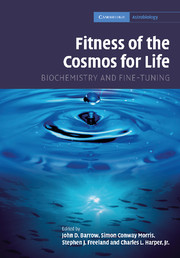Book contents
- Frontmatter
- Contents
- List of contributors
- Foreword: The improbability of life
- Preface
- Acknowledgments
- Part I The fitness of “fitness”: Henderson in context
- Part II The fitness of the cosmic environment
- Part III The fitness of the terrestrial environment
- Part IV The fitness of the chemical environment
- 16 Creating a perspective for comparing
- 17 Fine-tuning and interstellar chemistry
- 18 Framing the question of fine-tuning for intermediary metabolism
- 19 Coarse-tuning in the origin of life?
- 20 Plausible lipid-like peptides: prebiotic molecular self-assembly in water
- 21 Evolution revisited by inorganic chemists
- Index
- References
16 - Creating a perspective for comparing
Published online by Cambridge University Press: 18 December 2009
- Frontmatter
- Contents
- List of contributors
- Foreword: The improbability of life
- Preface
- Acknowledgments
- Part I The fitness of “fitness”: Henderson in context
- Part II The fitness of the cosmic environment
- Part III The fitness of the terrestrial environment
- Part IV The fitness of the chemical environment
- 16 Creating a perspective for comparing
- 17 Fine-tuning and interstellar chemistry
- 18 Framing the question of fine-tuning for intermediary metabolism
- 19 Coarse-tuning in the origin of life?
- 20 Plausible lipid-like peptides: prebiotic molecular self-assembly in water
- 21 Evolution revisited by inorganic chemists
- Index
- References
Summary
Introduction
Any chemist looking at the molecular workings of a living cell from the vantage point of organic chemistry may have moments in which he desists from scientific business-as-usual and finds himself standing in awe before so much “molecular ingenuity” and sheer chemical beauty. If anyone, besides the biochemist, may be fit to recognize such marvels on the molecular level and put them into a proper perspective, it is the synthetic organic chemist, who tends to judge any new discovered molecular structure or process by the criterion of whether he could do such a thing himself: “If I had to, could I make this?” The question reflects a dichotomy, epistemological in nature, that has been with the science of organic chemistry from the very beginning: the two-fold task of studying molecules occurring in nature and creating by chemical synthesis molecules that have never existed before. Chemical synthesis has traditionally been the organic chemist's major tool for exploring the molecular world: the ability to synthesize molecules of ever-increasing complexity that mirror those produced by living nature has been a significant measure of progress in organic chemistry as a whole. Yet, the gap between what chemists are able to create by chemical synthesis and what nature achieves in biosynthesis remains immense.
Fortunately, it is inspiration rather than resignation that chemists are drawing from this gap, and they are encouraged to do so by considering how chemical thought and the chemist's ability to make molecules have changed in the course of the past two centuries.
- Type
- Chapter
- Information
- Fitness of the Cosmos for LifeBiochemistry and Fine-Tuning, pp. 349 - 365Publisher: Cambridge University PressPrint publication year: 2007



